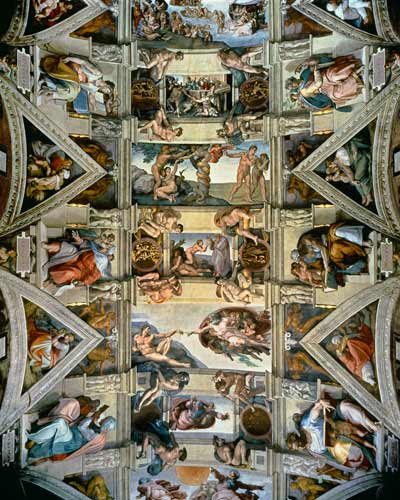Cards In This Set
| Front | Back |
|
Trecento
|
Italian word meaning 300; refers to 14th century (1300s)
|
 Identify |
School of Athens
Raphael
location: Vatican, opposite disputa
|
 Identify |
Moses
Michelangelo
For the unfinished Tomb of Pope Julius II
|
|
Saint Peter's Basilica
|
Originally designed by Bramante, then Sangallo, Michelangelo, and Maderna.
Piazza by Bernini
|
 Identify |
Sistine Chapel (Ceiling)
Michelangelo
Composed of:
4 corner triangles (Heroic Old Testament acts)
8 border triangles (biblical ancestors of Christ)
intermediate figures (prophets and pagan sybils)
9 central panels (events of Genesis)
|
|
Giovanni Boccaccio
|
Author
Decameron
Plague setting, 10 youths flee Florence and tell each other 10 stories a day for 10 days
|
|
Geoffery Chaucer
|
Author
died fittingly in 1400
Canterbury Tales: 30 travellers recount two stories each; never finished. All we have are 23 stories
|
|
Chiaroscuro
|
A painting technique that employs extreme contrasts between light and darkness
|
|
Fresco
|
Wall painting on moist plaster; a preferred medium of Florence
|
|
Oil paint
|
A medium allowing for rich layers of color; a favorite in Venice
|
 Identify |
Judith and Holofernes
Artemisia Gentileschi
depicts an Old Testament scene, borrows from Caravaggian use of light/dark. Her most famous painting
|
|
Donatello
|
Early Renaissance sculptor. Notable works include David (with Tuscan shepherd's hat), a wooden carving of an aged Mary Magdalene, and St. George (complete with shield)
|
|
Bernini
|
Baroque sculptor and architect
Notable works:
Piazza at St. Peter's Basilica
David (in action, biting lip and wearing an intense expression)
St. Theresa in Ecstasy
|
|
Rembrandt
|
Baroque painter
Used obvious Reformist religious motifs with an intimate, human feel
Notable works:
The Night Watch: a general consults with his second
Jacob Blessing the Sons of Joseph
|
|
Botticelli
|
Florentine Renaissance painter
Taken in by Medici family
Notable works:
Adoration of the Magi
La Primavera
The Birth of Venus
|



